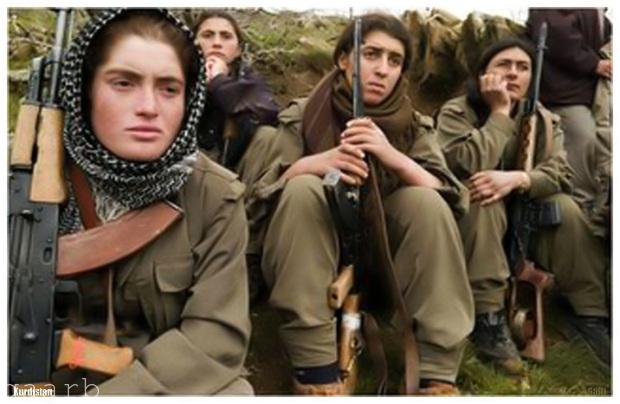
المصدر - When news of another mass shooting, this time in San Bernardino, California, began trickling into social media on the morning of December 2nd, we had two immediate reactions. First, an all too common, remorseful afterthought: how many more lives will be lost before ordinary citizens and policymakers in this country finally address the problem of gun violence? The second reaction was anxiety about the identities of the shooters. While roughly two-thirds of mass shooters are white men, we worried that if Muslim men had carried out the killings there would likely be an increase in Islamophobic rhetoric, which would drown out any space for inward reflection.
What we weren’t prepared to discover, however, was a 29-year-old woman leading the carnage—a mother who left her six-month old baby with relatives while she orchestrated a massacre with her American husband.
The idea of a mother terrorist is so jarring that she is seen as doubly deviant: first because of the magnitude of her violent actions, and second because through such violence, she betrays gender stereotypes. A day after the shootings, California Senator Dianne Feinstein, Vice Chair of the Senate Select Committee on Intelligence, told the media: “You and I know, that women, we wouldn’t leave a six month old—our baby—to do this, to don tactical gear to go in and kill a bunch of people. It’s not something a woman would easily do.”
This gender essentialism, however, betrays women’s reality. There is a long history of women picking up arms, joining men on the frontlines, planning and carrying out attacks, and leading revolutions. In their book Beyond Mothers, Monsters, and Whores, Caron Gentry and Laura Sjoberg emphasize that “women have always been, and continue to be, among the people engaged in violence in the global political arena.”
Guerrilla armies and extremist militant groups like Daesh, despite oppressing women, have been particularly welcoming of women cadre. Different rebel groups from Sri Lanka to Chechnya to Palestine have used all-female suicide bombing squads, in part because women and girls are often subject to less strict security measures than men. The female Peshmerga are regarded as the region’s greatest hope for reclaiming Kurdish lands from extremists. Women have even perpetrated genocidal violence in places like Rwanda. In Western all-volunteer militaries, women have been essential in the front-line fights in Iraq and Afghanistan.
Despite this reality, there has been little critical engagement with women who choose to break the essentialist stereotype, especially when it comes to violence and conflict. For a number of reasons, it is imperative to challenge the false dichotomy between men as protectors and perpetrators who are biologically inclined to violence, and women as victims and sufferers who are biologically predisposed towards peace.
First, by ignoring the reasons women choose to engage in violence, we fail to gain a full understanding of the underlying reasons why people engage in terrorism and other forms of political violence in the first place. Women may participate in violence for the same—or different—reasons as men, from economic expediency to the need for political activism, to the desire to step outside the confines of their homes to join a broader movement. In dismissing women’s participation in violence by characterizing it as “deviant” or “breaking from gender norms,” we miss the opportunity to understand important motivating factors. By better understanding the factors that push or pull women to use violence, we have a better chance of preventing or stopping violence in the first place.
Second, the agency and decision-making that women exercise during difficult circumstances are largely erased by the general tendency to see them only as sufferers. Focusing on the warrior-male and helpless-female binary robs women of credit for their frequent role in nation building and development during periods of conflict. For example, every year on December 16th, Bangladesh celebrates its victory against Pakistan in 1971. Bangladeshi women were active in the liberation movement as spies, nurses, cooks, and fighters on the battlefield. Today, however, they are most often remembered as widows and rape victims, while men freedom fighters enjoy honor and accolades. In other words, we tend to overlook the range of roles women play during violence.
Similarly, once conflict is over, women are expected to go back to their “natural” roles as mothers and wives and are hardly ever given space at the negotiating tables to decide their own future as ex-combatants, as well as the future of the country they fought for. For example, in Nepal, where women made up 20-30 percent of the almost 20,000 strong Maoist rebel army, women were not allowed to take part in the peace deals or the debates on disarmament and reintegration in a meaningful manner. Ignoring the range of roles women play during violence obscures the way that women’s role in violence may shape long-term patterns of violence and gender difference.
Women who choose to participate in state-sanctioned political violence do not fare much better. Rather than being lauded as war heroes, the women who have volunteered to fight America’s wars have been largely ignored or reduced to essentialist stereotypes. It was not until 2010 that the women who volunteered to support the U.S. in World War II, whether as nurses, pilots, or drivers, were recognized as military veterans. And today, the contention surrounding opening combat positions to women often focuses on biological essentialism rather than the proven track record of women combatants.
More research is needed to understand why Tashfeen Malik committed the atrocities in San Bernardino. The first step to doing this is to dismantle the binary essentialist notions of what women are capable of doing. Moving beyond the binary of warrior-male and helpless, peaceful female will allow us to focus more seriously on what leads women to engage in all roles—perpetrators, saviors, peacemakers, bystanders, and so forth—during violence. Re-thinking what women can do—and what they are already doing—to counter violence is one important step in working towards a more peaceful world.
Trishna Rana is an M.A. candidate*at the Josef Korbel School of International Studies and a fellow at the*Sié Chéou-Kang Center in International Security and Diplomacy, University of Denver.
Marie Berry is an Assistant Professor of Comparative and International Politics at the Josef Korbel School of International Studies, University of Denver.*










